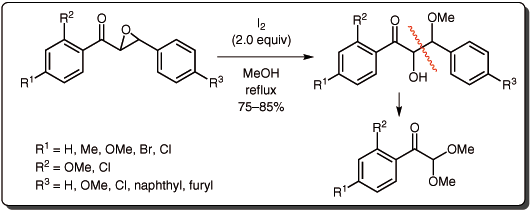Subscribe to RSS
Please copy the URL and add it into your RSS Feed Reader.
https://www.thieme-connect.de/rss/thieme/en/10.1055-s-00000083.xml
Synlett 2014; 25(11): 1591-1595
DOI: 10.1055/s-0033-1339134
DOI: 10.1055/s-0033-1339134
letter
Unusual Tandem Oxidative C–C Bond Cleavage and Acetalization of Chalcone Epoxides in the Presence of Iodine in Methanol
Authors
Further Information
Publication History
Received: 16 March 2014
Accepted after revision: 28 April 2014
Publication Date:
03 June 2014 (online)

Abstract
An unusual reaction of chalcone epoxides is observed where chalcone epoxides on heating with iodine in methanol leads to α,α-dimethoxyacetophenones, through C–C bond cleavage followed by acetalization of the formyl group. The process occurs through ring opening of the chalcone epoxide by methanol to form β-methoxy alcohol, cleavage of the C–C bond in the latter to form α-ketoaldehyde, and acetalization of the formyl group to give the product. The protocol provides direct access to α,α-dimethoxyacetophenones from chalcone epoxides.
Key words
oxidative cleavage - chalcone epoxides - iodine - α,α-dimethoxyacetophenones - acetals - α-ketoaldehydesSupporting Information
- for this article is available online at http://www.thieme-connect.com/products/ejournals/journal/
10.1055/s-00000083.
- Supporting Information (PDF) (opens in new window)
-
References and Notes
- 2 Antoniotti S, Dunach E. Synthesis 2003; 2753 ; and references cited therein
- 3a Kim J, Matsuyama S, Suzuki T. J. Labelled Compd. Raiopharm. 2004; 47: 921
- 3b Sankaranarayanan S, Chattopadhyay S. Tetrahedron: Asymmetry 1998; 9: 2627
- 3c Nagarkatti JP, Ashley KR. Tetrahedron Lett. 1973; 14: 4599
- 4a Ferreira JT. B, Brocksom TJ, Braga AL. Quim. Nova 1982; 5: 4
- 4b Brocksom TJ, Ferreira JT. B, Braga AL. J. Chem. Res., Synop. 1981; 10: 334
- 5 Roy SC, Adhikari S. Indian J. Chem., Sect. B: Org. Chem. Incl. Med. Chem. 1992; 31: 459
- 6 Mandal AK, Borude DP. Synth. Commun. 1991; 21: 111
- 7 Curci R, Lopez L, Troisi L, Rashid KS. M, Schaap PA. Tetrahedron Lett. 1998; 29: 3145
- 8 Bonchio M, Conte V, Di Furia F, Modena G. J. Mol. Catal. 1991; 71: 159
- 9a Ogata Y, Sawaki Y, Shimizu H. J. Org. Chem. 1978; 43: 1760
- 9b Hoffman J. J. Am. Chem. Soc. 1957; 79: 503
- 9c Temple RD. J. Org. Chem. 1970; 35: 1275
- 10 Binder CM, Dixon DD, Almaraz E, Tius MA, Singaram B. Tetrahedron Lett. 2008; 49: 2764
- 11 Miyamoto K, Tada N, Ochiai M. J. Am. Chem. Soc. 2007; 129: 2772
- 12 Hasegawa E, Ishiyama K, Horaguchi T, Shimizu T. J. Org. Chem. 1991; 56: 1631
- 13 Leitao AJ. L, Salvador JA. R, Pinto RM. A, Melo ML. S. Tetrahedron Lett. 2008; 49: 1694
- 14 Beebe TR, Hii P, Reinking P. J. Org. Chem. 1981; 46: 1927
- 15 Ayala-Mata F, Barrera-Mendoza C, Jimenez-Vazquez HA, Vargas-Diaz E, Zepeda LG. Molecules 2012; 17: 13864
- 16 General Procedure for Oxidative Cleavage of Chalcone Epoxides to α,α-Dimethoxy Acetophenones To a solution of an appropriate chalcone epoxide (1.0 mmol) in MeOH (3 mL) was added iodine (2.0 mmol) in one portion. The reaction mixture was refluxed for the appropriate time (monitored by TLC and visualized with 2,4-dinitrophenyl hydrazine stain). The reaction mixture was cooled to r.t. MeOH was evaporated under reduced pressure to obtain an oily residue that was purified by column chromatography (silica gel, 60–120 mesh size) using 5–10% EtOAc in PE as an eluent to obtain pure products. Pure products were identified by IR, 1H NMR, and 13C NMR spectroscopy and HRMS. Analytical Data of New Compounds 1-(2,4-Dichlorophenyl)-2,2-dimethoxyethanone (4f) Yield 75%; oil. FTIR (neat): 2939, 2833, 1707 (s), 1583, 1456, 1276, 1193, 867, 750 cm–1. HRMS: m/z calcd for C10H10ClO3Na [M + Na]+: 270.9967; found: 271.0039, 273.0010, 274.9986. 1H NMR (300 MHz, CDCl3): δ = 3.46 (s, 6 H), 5.16 (s, 1 H), 7.29–7.52 (m, 2 H), 7.63 (d, 1 H, J = 8.1 Hz). 13C NMR (300 MHz, CDCl3): δ = 54.5, 103.4, 127.0, 130.4, 131.1, 133.0, 134.2, 137.8, 195.3. 4-(2-Hydroxy-1-methoxy-3-oxo-3-phenylpropyl)benzo-nitrile (2b) Yield 95%; white solid; mp 87–89 °C. FTIR (neat): 3369, 2941, 2823, 2230, 1674 (s), 1597, 1448, 1224, 1114, 830, 736, 690 cm–1. DI-MS: m/z = 282.1 [M + H]+. 1H NMR (300 MHz, CDCl3): δ = 3.24 (s, 3 H), 3.62 (d, 1 H, J = 7.5 Hz), 4.53 (d, 1 H, J = 4.5 Hz), 5.35–5.38 (m, 1 H), 7.24 (d, 2 H, J = 8.7 Hz), 7.45–7.66 (m, 5 H), 7.84 (d, 2 H, J = 7.2 Hz). 13C NMR (300 MHz, CDCl3): δ = 57.6, 76.6, 85.0, 112.0, 118.5, 128.2, 128.6, 128.8, 131.8, 134.2, 134.6, 142.0, 199.0.

